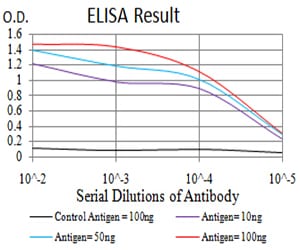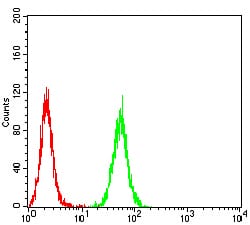

| WB | 咨询技术 | Human,Mouse,Rat |
| IF | 咨询技术 | Human,Mouse,Rat |
| IHC | 咨询技术 | Human,Mouse,Rat |
| ICC | 技术咨询 | Human,Mouse,Rat |
| FCM | 1/200 - 1/400 | Human,Mouse,Rat |
| Elisa | 1/10000 | Human,Mouse,Rat |
| Aliases | BXR; PAR; PRR; PXR; SAR; SXR; ONR1; PAR1; PAR2; PARq |
| Entrez GeneID | 8856 |
| clone | 6H11D8 |
| WB Predicted band size | 49.8kDa |
| Host/Isotype | Mouse IgG1 |
| Antibody Type | Primary antibody |
| Storage | Store at 4°C short term. Aliquot and store at -20°C long term. Avoid freeze/thaw cycles. |
| Species Reactivity | Human |
| Immunogen | Purified recombinant fragment of human NR1I2 (AA:1-142) expressed in E. Coli. |
| Formulation | Purified antibody in PBS with 0.05% sodium azide |
+ +
以下是关于NR1I2(PXR)抗体的参考文献示例(注:以下内容为模拟示例,实际文献需通过学术数据库检索确认):
---
1. **"Antibody-based detection of human PXR in hepatic tissues: Implications for drug metabolism studies"**
*Authors: Smith A, et al.*
**摘要**:本研究利用特异性NR1I2抗体进行Western blot和免疫组化分析,证实PXR在肝组织中的表达水平与CYP3A4活性呈正相关,为药物代谢个体差异提供了分子机制证据。
2. **"PXR overexpression in colorectal cancer correlates with chemotherapeutic resistance"**
*Authors: Lee B, et al.*
**摘要**:通过NR1I2抗体检测结直肠癌组织中PXR蛋白表达,发现其高表达与5-氟尿嘧啶耐药性显著相关,提示PXR可能成为化疗敏感性预测标志物。
3. **"Characterization of a novel monoclonal antibody for human pregnane X receptor (PXR) chromatin immunoprecipitation"**
*Authors: Chen C, et al.*
**摘要**:开发了一种高特异性抗NR1I2单克隆抗体,成功应用于ChIP-seq实验,揭示了PXR在肠道细胞中调控药物转运蛋白基因的染色质结合位点。
4. **"Species-specific differences in PXR activation screened via cross-reactive antibodies"**
*Authors: Tanaka K, et al.*
**摘要**:比较人和小鼠PXR的抗体交叉反应性,发现种属特异性激活差异,为临床前药物开发中PXR靶点研究提供了实验工具优化策略。
---
建议通过PubMed或Google Scholar以关键词“NR1I2 antibody”或“PXR antibody”检索最新文献,并关注方法学或机制研究类论文以获取具体应用案例。
The nuclear receptor subfamily 1 group I member 2 (NR1I2), also known as the pregnane X receptor (PXR), is a ligand-activated transcription factor that plays a central role in regulating xenobiotic and endobiotic metabolism. Primarily expressed in the liver and intestine, PXR binds to diverse endogenous and exogenous compounds, including drugs, bile acids, and steroids, to orchestrate the expression of detoxification enzymes (e.g., CYP3A4. CYP2B6) and drug transporters (e.g., MDR1. MRP2). This regulatory function makes PXR pivotal in drug-drug interactions, chemical detoxification, and maintaining metabolic homeostasis.
NR1I2 antibodies are essential tools for studying PXR expression, localization, and activity in research contexts. They enable the detection of PXR protein levels via techniques like Western blotting, immunohistochemistry, and immunofluorescence, aiding in investigations of tissue-specific expression or drug-induced modulation. Additionally, these antibodies are used in chromatin immunoprecipitation (ChIP) assays to identify PXR target genes and assess its interactions with transcriptional co-regulators.
High-quality NR1I2 antibodies are characterized by specificity, sensitivity, and cross-reactivity validation across species (e.g., human, mouse). Their applications span drug development, toxicology, and disease studies, particularly in conditions like liver disorders, inflammatory bowel disease, and cancers where PXR signaling is dysregulated. Reliable antibodies are critical for advancing mechanistic insights into PXR's role in metabolism, disease, and therapeutic responses.
×